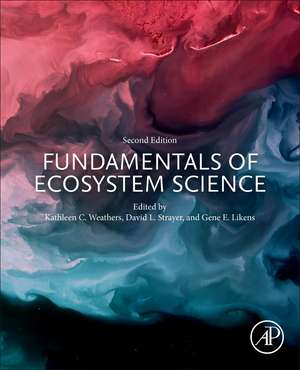Fundamentals of Ecosystem Science
Editat de Kathleen C. Weathers, David L. Strayer, Gene E. Likensen Limba Engleză Paperback – 26 iul 2021
For those choosing to use the book in a classroom environment, or who want to enrich further their reading experience, teaching and learning assets are available at Elsevier.com.
- Covers both aquatic (freshwater and marine) and terrestrial ecosystems with updated information
- Includes a new chapter on microbial biogeochemistry
- Features vignettes throughout the book with real examples of how an ecosystem approach has led to important change in policy, management, and ecological understanding
- Demonstrates the application of an ecosystem approach in synthesis chapters and case studies
- Contains new coverage of human-environment interactions
Preț: 409.15 lei
Preț vechi: 547.05 lei
-25% Nou
Puncte Express: 614
Preț estimativ în valută:
78.30€ • 81.28$ • 65.29£
78.30€ • 81.28$ • 65.29£
Carte tipărită la comandă
Livrare economică 15-29 martie
Preluare comenzi: 021 569.72.76
Specificații
ISBN-13: 9780128127629
ISBN-10: 0128127627
Pagini: 358
Dimensiuni: 191 x 235 x 24 mm
Greutate: 0.62 kg
Ediția:2
Editura: ELSEVIER SCIENCE
ISBN-10: 0128127627
Pagini: 358
Dimensiuni: 191 x 235 x 24 mm
Greutate: 0.62 kg
Ediția:2
Editura: ELSEVIER SCIENCE
Public țintă
Managers in ecology, environmental sciences and allied fields. Researchers in allied fields to ecology and environmental sciences like geochemistry, green chemistry, environmental chemistry, geomorphology, sustainability, global change, atmospheric science and conservation biology. Advanced undergraduate, graduate students and faculty in ecology and environmental scienceCuprins
Section 1: Introduction
1. Introduction
Section 2: Ecological Energetics
2. Primary Production
3. Secondary Production
4. Decomposition
5. Microbially Mediated Redox Reactions
Section 3: Biogeochemistry
6. Intro to Element Cycling
7. Carbon Cycle
8. Nitrogen Cycle
9. Phosphorus Cycle
Section 4: Synthesis
10. Revisiting the Ecosystem Concept: Important Features that Promote Generality and Understanding
11. Ecosystems in a heterogeneous world
12. Controls on ecosystem structure and function
Section 5: Case Studies
13. Streams and their valleys
14. Ecology of lyme disease
15. Understanding Ecosystem Effects of Dams
16. Acid Rain
17. Surprising ecosystem changes in the Naragannsett Bay
18. From global environmental change to sustainability science: Ecosystem studies in Yaqui Valley Mexico
Section 6: Frontiers
19. Ecosystem science: the continuing evolution of our discipline
1. Introduction
Section 2: Ecological Energetics
2. Primary Production
3. Secondary Production
4. Decomposition
5. Microbially Mediated Redox Reactions
Section 3: Biogeochemistry
6. Intro to Element Cycling
7. Carbon Cycle
8. Nitrogen Cycle
9. Phosphorus Cycle
Section 4: Synthesis
10. Revisiting the Ecosystem Concept: Important Features that Promote Generality and Understanding
11. Ecosystems in a heterogeneous world
12. Controls on ecosystem structure and function
Section 5: Case Studies
13. Streams and their valleys
14. Ecology of lyme disease
15. Understanding Ecosystem Effects of Dams
16. Acid Rain
17. Surprising ecosystem changes in the Naragannsett Bay
18. From global environmental change to sustainability science: Ecosystem studies in Yaqui Valley Mexico
Section 6: Frontiers
19. Ecosystem science: the continuing evolution of our discipline
